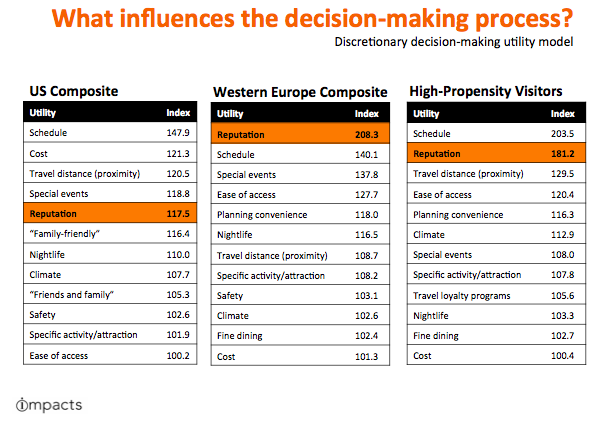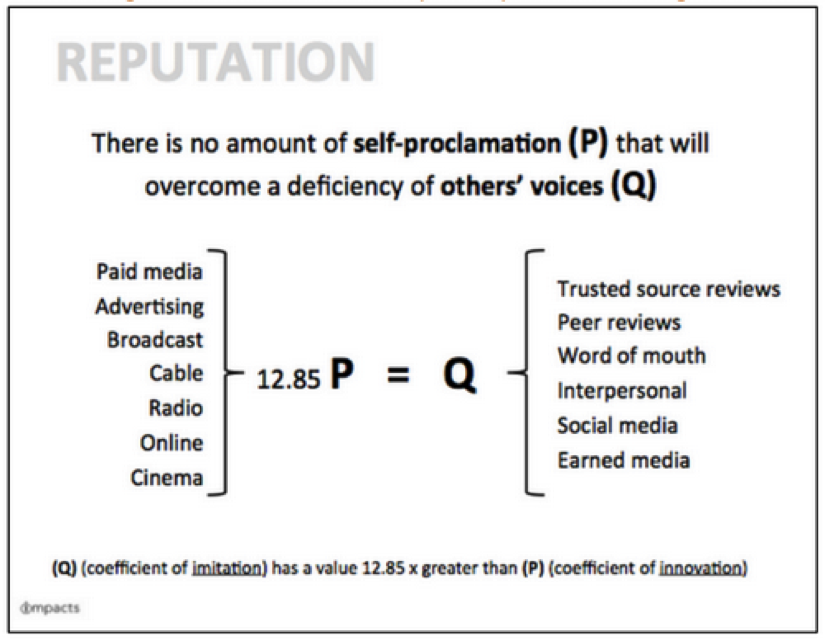
How does social media play an important role in driving visitation to cultural organizations?
It’s rather straightforward. The answer is in how these social platforms influence an organizations’ reputation. Take a closer look at the data introduced in today’s video below.
Here is how social media drives visitation in a big way:
1) Reputation plays a major role in motivating visitation.
This is especially true regarding high-propensity visitors.
2) Social media plays a major role in driving reputation.
What others say about an organization is more important in influencing an organization’s reputation than what the organization says about itself -12.85 TIMES more important! Makes sense if you think about it, right? Well, there’s actually math around it.
The value is an outcome of a diffusion model developed by IMPACTS to quantify the relative influence of imitation when compared to innovation on the adoption or trial of a product. Frank Bass pioneered this work in 1969 with the publication of his paper “A New Product Growth for Model Consumer Durables” and many persons and organizations – IMPACTS included – have iterated and expanded on this original work for various applications. Reliably, the average value of “q” has approximated 13x that of the average value “p.” The IMPACTS application of this method averages a “q” value that is 12.85x that of “p,” and, thus, I reference this specific value in instances informed by IMPACTS data.
3) Thus, social media plays an important role in driving visitation.
There’s no functional amount of paid media that can overcome negative reviews – or a lack of reviews from trusted sources, for that matter. Effective social media strategy is critical for organizations aiming to maximize engagement.
It’s not an anecdote or a wish upon a star…it’s math.
Words to know to be in-the-know:
High-propensity visitors:
These are the folks who demonstrate the demographic, psychographic, and behavioral attributes that indicate an increased likelihood to visit a cultural organization. These are the people who actually go to museums, zoos, aquariums, botanic gardens, performing arts events, etc. In short, they are the market segment keeping your organization’s doors open.
Coefficient of innovation:
The “P” value in the diffusion model. The coefficient of innovation includes messages that your organization pays to say about itself. Examples include radio spots, television, and nearly all forms of traditional advertising.
Coefficient of imitation:
The “Q” value in the diffusion model. The coefficient of imitation includes reviews from trusted resources. Examples include earned media, peer-review sites (think Yelp and TripAdvisor), word of mouth and, of course, social media. Reputation is a driver of visitation.
IMPACTS Experience provides data for the world’s leading organizations through workshops, keynote presentations, webinars, and data services such as pricing recommendations, market potential analyses, concept testing, and Awareness, Attitude, and Usage studies. Learn more.
We publish new national data and analysis every other Wednesday. Don’t want to miss an update? Subscribe here to get the most recent data and analysis in your inbox.














